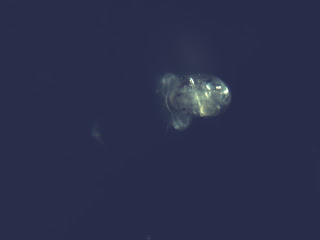Dark Knight
"You merely adopted adopted the dark; I was born in it, molded by it. I didn't see the light until I was already a man."
- the movie Dark Knight Rises
Our first scientific task in Ny-Ålesund was to collect larvae. We headed down to the pier right outside the marine lab with a plankton net, two buckets to hold our samples, and a radio for safety. It was pitch black outside except for the glow from the windows of the marine lab across the harbor. My student, Kharis, drove our two buckets into the snow for safe-keeping while I tied the plankton net to a cleat. We've collected plenty of plankton samples together before. This was a routine operation - except for the 20 mph wind, of course.
After dragging the plankton net back and forth in the water several times, we emptied the collector at the end of our net into one of the buckets and headed up the stairs to the other side of the pier. Here, it was less sheltered, and the waves made a standard operation difficult. Instead, we threw the net into the ocean like a frisbee and held tension on the line while water flowed through it. After about a half hour, we had two good plankton samples to analyze.
In essence, we're trying to figure out what in the world larvae are doing in the water column in the middle of the polar night. It's cold; it's dark; there's nothing to eat. Are they even supposed to be there? Do the sensitive, mortality-prone babies want to be swimming around in a soup of things that could eat them, when there's nothing for them to eat in turn? Or is this all a mistake, and any larvae who find themselves in the dark winter are bound for death? If they can survive, then how? What are they eating? Do they have enough energy to settle back down to the seafloor and become juveniles? I've been brooding on these questions ever since I first found larvae during the polar night in 2020. I just have to know how they live.
The original plan for this trip included two experiments using larvae we collected. All the larvae had to belong to the same species for the experiments to work - between 400 and 600 larvae in total. I didn't think that number was too far-fetched (last time I was in Ny-Ålesund, I went home with 464 larvae). Here's the thing, though: getting 400 larvae is one matter. Getting 400 larvae of the same species is an entirely different thing altogether.
As Kharis and I sorted larvae from our samples in the lab, we were excited to find a good number - 47 individuals, about 10% of what we needed and great progress for our first day. Except that those 47 larvae belonged to a dozen different species. It was a bad sign for our experimental design.
I think we can switch our experimental design a little and do a community-level analysis instead of a detailed study of just one species. We will still be able to answer our scientific questions, and this way, we will learn about all the larvae we find, not just one common species. I had to smile at the fact that we were exactly one day into our sampling, and we were already considering Plan B. Honestly, this is par for the course in the Arctic.
Overall, it was a very successful first day. Check out a few of the larvae we caught in the photos below!
 |
| This is a baby snail, also called a gastropod veliger. The two clear lobes you see on the left side its body are covered in tiny hairs called cilia that help it swim and feed. The snail's shell is on the right side in this image. I believe this specimen will grow up to be a nudibranch (sea slug). It was photographed at 40x magnification while swimming around on a microscope slide. Photo by Kharis Schrage. |
 |
| This is a cyphonautes larva. It has little hairs (cilia) all along the bottom edge of its triangular body that help it swim and feed. It will grow up to be a bryozoan like Alcyonidium. This specimen was photographed using a compound microscope at 100x magnification. Photo by Kharis Schrage. |

Comments
Post a Comment